- spring的整体架构
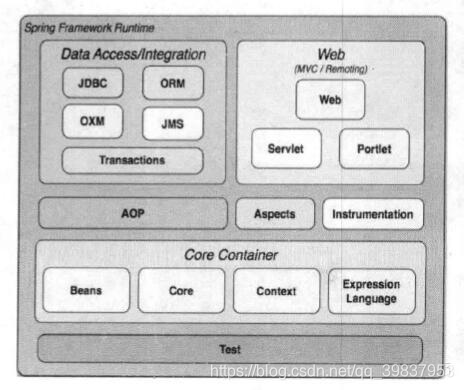
可以看到整体架构分为5个大的组成部分。
1.Data Access/Integration
2.Web
3.Aop
4.Core Container
5.Test
- Data Access/Integration
- JDBC模块提供了一个JDBC抽象层,它可以消除冗长的JDBC编码和解析数据库厂商特有的错误代码,这个模块包含了Spring对JDBC数据访问进行封装的所有类
- ORM模块为流行的对象-关系映射API,如JPA、JDO、Hibernate、iBatis等,提供了一个交互层,利用ORM封装包,可以混合使用所有Spring提供的特性进行O/R映射,如前边提到的简单声明性事务管理
- Web
Web上下文模块建立在应用程序上下文模块之上,为基于Web的应用程序提供了上下文,所以Spring框架支持与Jakarta Struts的集成。Web模块还简化了处理多部分请求以及将请求参数绑定到域对象的工作。Web层包含了Web、Web-Servlet、Web-Struts和Web、Porlet模块
- Web模块:提供了基础的面向Web的集成特性,例如,多文件上传、使用Servlet listeners初始化IoC容器以及一个面向Web的应用上下文,它还包含了Spring远程支持中Web的相关部分
- Web-Servlet模块web.servlet.jar:该模块包含Spring的model-view-controller(MVC)实现,Spring的MVC框架使得模型范围内的代码和web
forms之间能够清楚地分离开来,并与Spring框架的其他特性基础在一起 - Web-Struts模块:该模块提供了对Struts的支持,使得类在Spring应用中能够与一个典型的Struts Web层集成在一起
- Web-Porlet模块:提供了用于Portlet环境和Web-Servlet模块的MVC的实现
- AOP
- AOP模块提供了一个符合AOP联盟标准的面向切面编程的实现,它让你可以定义例如方法拦截器和切点,从而将逻辑代码分开,降低它们之间的耦合性,利用source-level的元数据功能,还可以将各种行为信息合并到你的代码中
- Spring AOP模块为基于Spring的应用程序中的对象提供了事务管理服务,通过使用Spring
AOP,不用依赖EJB组件,就可以将声明性事务管理集成到应用程序中 - Core Container
Core Container(核心容器)包含有Core、Beans、Context和Expression Language模块
Core和Beans模块是框架的基础部分,提供IoC(转控制)和依赖注入特性。这里的基础概念是BeanFactory,它提供对Factory模式的经典实现来消除对程序性单例模式的需要,并真正地允许你从程序逻辑中分离出依赖关系和配置
-
Core模块主要包含Spring框架基本的核心工具类
-
Beans模块是所有应用都要用到的,它包含访问配置文件、创建和管理bean以及进行Inversion of Control/Dependency Injection(Ioc/DI)操作相关的所有类
-
Context模块构建于Core和Beans模块基础之上,提供了一种类似于JNDI注册器的框架式的对象访问方法。Context模块继承了Beans的特性,为Spring核心提供了大量扩展,添加了对国际化(如资源绑定)、事件传播、资源加载和对Context的透明创建的支持。ApplicationContext接口是Context模块的关键
-
ExpressionLanguage模块:提供了一个强大的表达式语言用于在运行时查询和操纵对象,该语言支持设置/获取属性的值,属性的分配,方法的调用,访问数组上下文、容器和索引器、逻辑和算术运算符、命名变量以及从Spring的IoC容器中根据名称检索对象
-
容器实现的核心类
-
DefaultListableBeanFactory
XmlBeanFactory继承自DefaultListableBeanFactory,而DefaultListableBeanFactory是整个bean加载的核心部分,是Spring注册及加载bean的默认实现,而对于XmlBeanFactory与DefaultListableBeanFactory不同的地方其实是在XmlBeanFactory中使用了自定义的XML读取器XmlBeanDefinitionReader,实现了个性化的BeanDefinitionReader读取,DefaultListableBeanFactory继承了AbstractAutowireCapableBeanFactory并实现了ConfigURableListableBeanFactory以及BeanDefinitionRegistry接口。以下是ConfigURationListableBeanFactory的相关类图
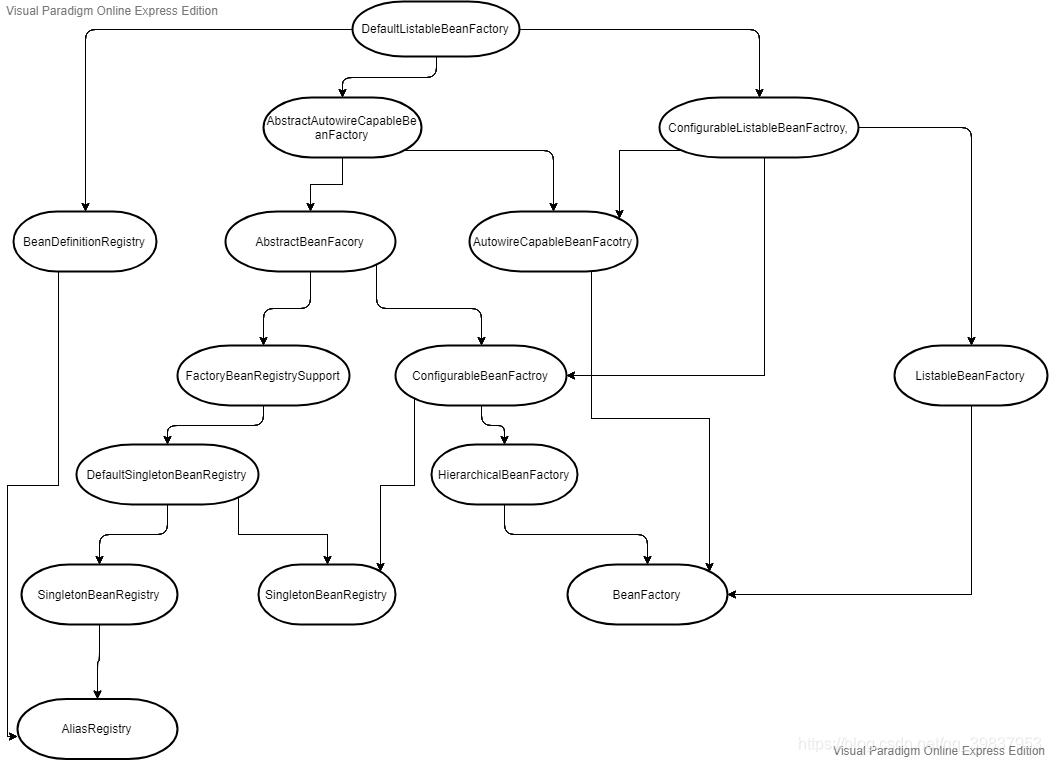
-
AliasRegistry:定义对alias的简单增删改等操作
-
SimpleAliasRegistry:主要使用map作为alias的缓存,并对接口AliasRegistry进行实现
-
SingletonBeanRegistry:定义对单例的注册及获取
-
BeanFactory:定义获取bean及bean的各种属性
-
DefaultSingletonBeanRegistry:对接口SingletonBeanRegistry各函数的实现
-
HierarchicalBeanFactory:继承BeanFactory,也就是在BeanFactory定义的功能的基础上增加了对parentFactory的支持
-
BeanDefinitionRegistry:定义对BeanDefinition的各种增删改操作
-
FactoryBeanRegistrySupport:在DefaultSingletonBeanRegistry基础上增加了对FactoryBean的特殊处理功能
-
ConfigurableBeanFactory:提供配置Factory的各种方法
-
ListableBeanFactory:根据各种条件获取bean的配置清单
-
AbstractBeanFactory:综合FactoryBeanRegistrySupport和ConfigurationBeanFactory的功能
-
AutowireCapableBeanFactory:提供创建bean、自动注入、初始化以及应用bean的后处理器
-
AbstractAutowireCapableBeanFactory:综合AbstractBeanFactory并对接口AutowireCapableBeanFactory进行实现
-
ConfigurableListableBeanFactory:BeanFactory配置清单,指定忽略类型及接口等
-
DefaultListableBeanFactory:综合上面所有功能,主要是对Bean注册后的处理
XmlBeanFactory对DefaultListableBeanFactory类进行了扩展,主要用于从XML文档中读取BeanDefinition,对于注册及获取Bean都是使用从父类DefaultListableBeanFactory继承的方法去实现,而唯独与父类不同的个性化实现就是增加了XmlBeanDefinitionReader类型的reader属性。在XmlBeanFactory中主要使用reader属性对资源文件进行读取和注册
- XmlBeanDefinitionReader
XML配置文件的读取是Spring中重要的功能,因为Spring的大部分功能都是以配置作为切入点的,可以从XmlBeanDefinitionReader中梳理一下资源文件读取、解析及注册的大致脉络,首先看看各个类的功能
- ResourceLoader:定义资源加载器,主要应用于根据给定的资源文件地址返回对应的Resource
- BeanDefinitionReader:主要定义资源文件读取并转换为BeanDefinition的各个功能
- EnvironmentCapable:定义获取Environment方法
- DocumentLoader:定义从资源文件加载到转换为Document的功能
- AbstractBeanDefinitionReader:对EnvironmentCapable、BeanDefinitionReader类定义的功能进行实现
- BeanDefinitionDocumentReader:定义读取Document并注册BeanDefinition功能
- BeanDefinitionParserDelegate:定义解析Element的各种方法
相关类图:
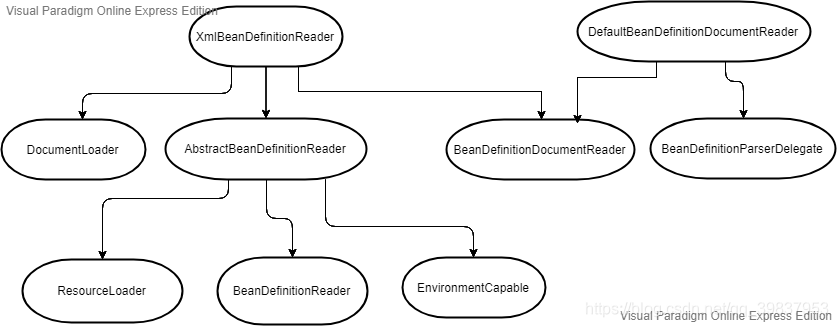
准备工作准备完毕,现在来讲下关于这段代码经历了些什么。
BeanFactory bf = new XmlBeanFactory(new ClassPathResource("beanFactoryTest.xml"));
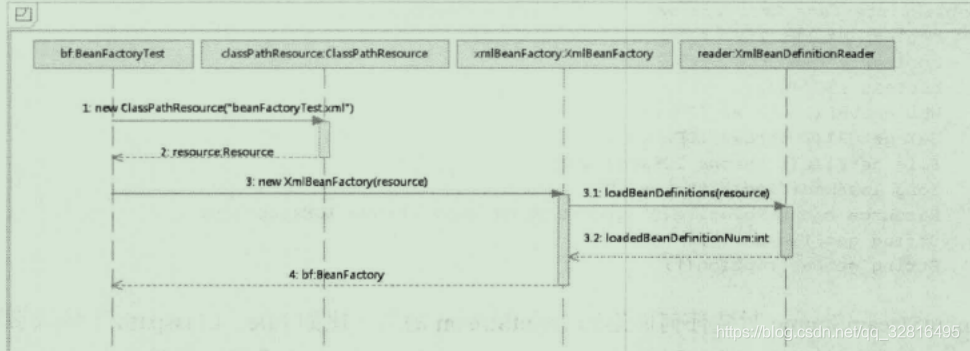
整个XML配置文件读取的大致流程,在XmlBeanDefinitionReader中主要包含以下几步处理
- (1)通过继承自AbstractBeanDefinitionReader中的方法,来使用ResourceLoader将资源文件路径转换为对应的Resource文件
- (2)通过DocumentLoader对Resource文件进行转换,将Resource文件转换为Document文件
- (3)通过实现接口BeanDefinitionDocumentReader的DefaultBeanDefinitionDocumentReader类对Document进行解析,并使用BeanDefinitionParserDelegate对Element进行解析
时序图从BeanFactoryTest测试类开始,首先调用ClassPathResource的构造函数来构造Resource资源文件的实例对象,这样后续的资源处理就可以用Resource提供的各种服务来操作了
Spring的配置文件读取是通过ClassPathResource进行封装的,Spring对其内部使用到的资源实现了自己的抽象结构:Resource接口来封装底层资源
public interface InputStreamSource {
InputStream getInputStream() throws IOException;
}
public interface Resource extends InputStreamSource {
boolean exists();
boolean isReadable();
boolean isOpen();
URL getURL() throws IOException;
URI getURI() throws IOException;
File getFile() throws IOException;
long lastModified() throws IOException;
Resource createRelative(String var1) throws IOException;
String getFilename();
String getDescription();
}
InputStreamSource封装任何能返回InputStream的类,比如File、Classpath下的资源和Byte Array等, 它只有一个方法定义:getInputStream(),该方法返回一个新的InputStream对象
Resource接口抽象了所有Spring内部使用到的底层资源:File、URL、Classpath等。首先,它定义了3个判断当前资源状态的方法:存在性(exists)、可读性(isReadable)、是否处于打开状态(isOpen)。另外,Resource接口还提供了不同资源到URL、URI、File类型的转换,以及获取lastModified属性、文件名(不带路径信息的文件名,getFilename())的方法,为了便于操作,Resource还提供了基于当前资源创建一个相对资源的方法:createRelative(),还提供了getDescription()方法用于在错误处理中的打印信息
对不同来源的资源文件都有相应的Resource实现:文件(FileSystemResource)、Classpath资源(ClassPathResource)、URL资源(UrlResource)、InputStream资源(InputStreamResource)、Byte数组(ByteArrayResource)等
当通过Resource相关类完成了对配置文件进行封装后,配置文件的读取工作就全权交给XmlBeanDefinitionReader来处理了
XmlBeanFactory的初始化有若干办法,Spring提供了很多的构造函数,在这里分析的是使用Resource实例作为构造函数参数的办法,代码如下
public XmlBeanFactory(Resource resource) throws BeansException {
//调用XmlBeanFactory(Resource,BeanFactory)构造方法
this(resource, (BeanFactory)null);
}
//parentBeanFactory为父类BeanFactory用于factory合并,可以为空
public XmlBeanFactory(Resource resource, BeanFactory parentBeanFactory) throws BeansException {
super(parentBeanFactory);
this.reader = new XmlBeanDefinitionReader(this);
this.reader.loadBeanDefinitions(resource);
上面函数中的代码this.reader.loadBeanDefinitions(resource)才是资源加载的真正实现,时序图中提到的XmlBeanDefinitionReader加载数据就是在这里完成的,但是在XmlBeanDefinitionReader加载数据前还有一个调用父类构造函数初始化的过程:super(parentBeanFactory),跟踪代码到父类AbstractAutowireCapableBeanFactory的构造函数中:
public AbstractAutowireCapableBeanFactory() {
super();
this.ignoreDependencyInterface(BeanNameAware.class);
this.ignoreDependencyInterface(BeanFactoryAware.class);
this.ignoreDependencyInterface(BeanClassLoaderAware.class);
}
ignoreDependencyInterface的主要功能是忽略给定接口的自动装配功能,实现方式:实现了BeanNameAware接口的属性。所以不会被Spring自动初始化。自动装配时忽略给定的依赖接口,典型应用是通过其他方式解析Application上下文注册依赖,类似于BeanFactory通过BeanFactoryAware进行注入或者ApplicationContext通过ApplicationContextAware进行注入
- 加载Bean
this.reader.loadBeanDefinitions(resource),这句代码是整个资源加载的切入点,这个方法的时序图如下
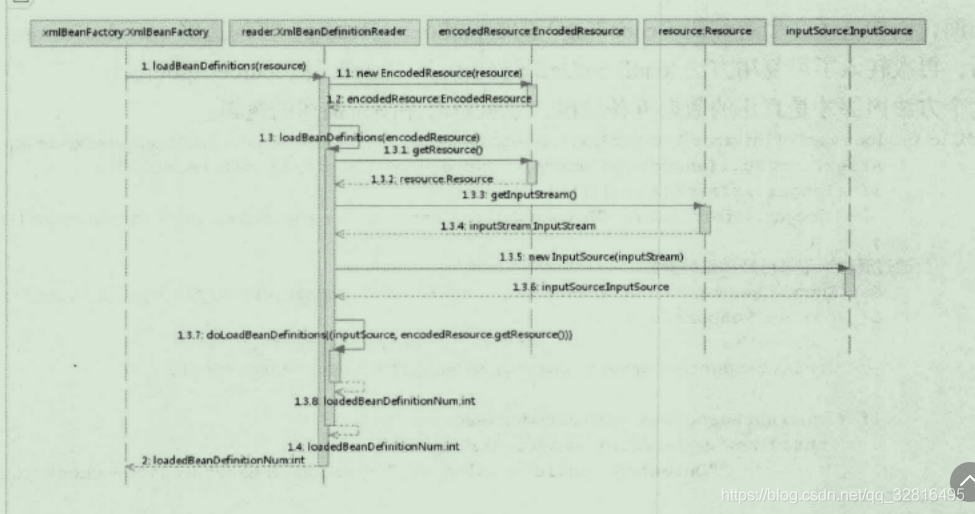
- (1)封装资源文件。当进入XmlBeanDefinitionReader后首先对参数Resource使用EncodedResource类进行封装
- (2)获取输入流。从Resource中获取对应的InputStream并构造InputSource
- (3)通过构造的InputSource实例和Resource实例继续调用函数doLoadBeanDefinitions,loadBeanDefinitions函数具体的实现过程:
public int loadBeanDefinitions(Resource resource) throws BeanDefinitionStoreException {
return this.loadBeanDefinitions(new EncodedResource(resource));
}
EncodedResource的作用是对资源文件的编码进行处理的,其中的主要逻辑体现在getReader()方法中,当设置了编码属性的时候Spring会使用相应的编码作为输入流的编码
public Reader getReader() throws IOException {
return this.encoding != null?new InputStreamReader(this.resource.getInputStream(), this.encoding):new InputStreamReader(this.resource.getInputStream());
}
在构造好了encodeResource对象后,再次转入了可复用方法loadBeanDefinitions(new EncodedResource(resource)),这个方法内部才是真正的数据准备阶段
public int loadBeanDefinitions(EncodedResource encodedResource) throws BeanDefinitionStoreException {
Assert.notNull(encodedResource, "EncodedResource must not be null");
if(this.logger.isInfoEnabled()) {
this.logger.info("Loading XML bean definitions from " + encodedResource.getResource());
}
//通过属性来记录已经加载的资源
Object currentResources = (Set)this.resourcesCurrentlyBeingLoaded.get();
if(currentResources == null) {
currentResources = new HashSet(4);
this.resourcesCurrentlyBeingLoaded.set(currentResources);
}
if(!((Set)currentResources).add(encodedResource)) {
throw new BeanDefinitionStoreException("Detected cyclic loading of " + encodedResource + " - check your import definitions!");
} else {
int var6;
try {
//从encodedResource中获取已经封装的Resource对象并再次从Resource中获取其中的InputStream
InputStream ex = encodedResource.getResource().getInputStream();
try {
InputSource inputSource = new InputSource(ex);
if(encodedResource.getEncoding() != null) {
inputSource.setEncoding(encodedResource.getEncoding());
}
//真正进入了逻辑核心部分
var6 = this.doLoadBeanDefinitions(inputSource, encodedResource.getResource());
} finally {
ex.close();
}
} catch (IOException var15) {
throw new BeanDefinitionStoreException("IOException parsing XML document from " + encodedResource.getResource(), var15);
} finally {
((Set)currentResources).remove(encodedResource);
if(((Set)currentResources).isEmpty()) {
this.resourcesCurrentlyBeingLoaded.set((Object)null);
}
}
return var6;
}
}
数据准备阶段的逻辑:首先对传入的resource参数做封装,目的是考虑到Resource可能存在编码要求的情况,其次,通过SAX读取XML文件的方式来准备InputSource对象,最后将准备的数据通过参数传入真正的核心处理部分doLoadBeanDefinitions(inputSource,encodedResource.getResource())
protected int doLoadBeanDefinitions(InputSource inputSource, Resource resource) throws BeanDefinitionStoreException {
try {
int ex = this.getValidationModeForResource(resource);
Document doc = this.documentLoader.loadDocument(inputSource, this.getEntityResolver(), this.errorHandler, ex, this.isNamespaceAware());
return this.registerBeanDefinitions(doc, resource);
} catch (BeanDefinitionStoreException var5) {
throw var5;
} catch (SAXParseException var6) {
throw new XmlBeanDefinitionStoreException(resource.getDescription(), "Line " + var6.getLineNumber() + " in XML document from " + resource + " is invalid", var6);
} catch (SAXException var7) {
throw new XmlBeanDefinitionStoreException(resource.getDescription(), "XML document from " + resource + " is invalid", var7);
} catch (ParserConfigurationException var8) {
throw new BeanDefinitionStoreException(resource.getDescription(), "Parser configuration exception parsing XML from " + resource, var8);
} catch (IOException var9) {
throw new BeanDefinitionStoreException(resource.getDescription(), "IOException parsing XML document from " + resource, var9);
} catch (Throwable var10) {
throw new BeanDefinitionStoreException(resource.getDescription(), "Unexpected exception parsing XML document from " + resource, var10);
}
}
上面的代码作用有三点:
- 1.获取对XML文件的验证模式
- 2.加载XML文件,并得到对应的Document
- 3.根据返回的Document注册Bean信息
接下来我们分别说下这三点的具体细节。
- 获取对XML文件的验证模式
XML文件的验证模式保证了XML文件的正确性,而比较常用的验证模式有两种:DTD和XSD - DTD
1.概念: DTD(Document Type Definition)即文档类型定义,是一种XML约束模式语言,是XML文件的验证机制,属于XML文件组成的一部分
2.作用:判断文档是否符合规范,元素和标签使用是否正确
3.例子:Spring中使用DTD声明方式的代码如下
<?xml version="1.0" encoding="UTF-8"?>
<!DOCTYPE beans PUBLIC "-//Spring//DTD BEAN 2.0//EN" "http://www.Springframework.org/dtd/Spring-beans-2.0.dtd">
...
- XML
- 1.概念: XML Schema语言就是XSD(XML Schemas Definition),XML Schema描述了XML文档的结构。
- 2.作用:检查该XML文档是否符合其要求,文档设计者可以通过XML Schema指定一个XML文档所允许的结构和内容,并可据此检查一个XML文档是否是有效的
- 3.例子:Spring中使用DTD声明方式的代码如下
- 4.注意:XML Schema文档对XML实例文档进行检验,除了要声明名称空间外(xmlns=http://www.Springframework.org/schema/beans),还必须指定该名称空间所对应的XML Schema文档的存储位置,通过schemaLocation属性来指定名称空间所对应的XML Schema文档的存储位置,它包含两个部分,一部分是名称空间的URI,另一部分就该名称空间所标识的XML Schema文件位置或URL地址
- 验证模式的读取
protected int getValidationModeForResource(Resource resource) {
int validationModeToUse = this.getValidationMode();
//如果手动指定了验证模式则使用指定的验证模式
if(validationModeToUse != 1) {
return validationModeToUse;
} else {
//如果未指定则使用自动检测
int detectedMode = this.detectValidationMode(resource);
return detectedMode != 1?detectedMode:3;
}
}
自动检测验证模式的功能是在函数detectValidationMode方法中实现的,在detectValidationMode函数中又将自动检测验证模式的工作委托给了专门处理类XmlValidationModeDetector的detectValidationMode方法
protected int detectValidationMode(Resource resource) {
if(resource.isOpen()) {
throw new BeanDefinitionStoreException("Passed-in Resource [" + resource + "] contains an open stream: " + "cannot determine validation mode automatically. Either pass in a Resource " + "that is able to create fresh streams, or explicitly specify the validationMode " + "on your XmlBeanDefinitionReader instance.");
} else {
InputStream inputStream;
try {
inputStream = resource.getInputStream();
} catch (IOException var5) {
throw new BeanDefinitionStoreException("Unable to determine validation mode for [" + resource + "]: cannot open InputStream. " + "Did you attempt to load directly from a SAX InputSource without specifying the " + "validationMode on your XmlBeanDefinitionReader instance?", var5);
}
try {
return this.validationModeDetector.detectValidationMode(inputStream);
} catch (IOException var4) {
throw new BeanDefinitionStoreException("Unable to determine validation mode for [" + resource + "]: an error occurred whilst reading from the InputStream.", var4);
}
}
}
XmlValidationModeDetector类中的detectValidationMode方法如下
public int detectValidationMode(InputStream inputStream) throws IOException {
BufferedReader reader = new BufferedReader(new InputStreamReader(inputStream));
try {
boolean isDtdValidated = false;
while(true) {
String content;
if((content = reader.readLine()) != null) {
content = this.consumeCommentTokens(content);
//如果读取的行是空或者注释则略过
if(this.inComment || !StringUtils.hasText(content)) {
continue;
}
if(this.hasDoctype(content)) {
isDtdValidated = true;
} else if(!this.hasOpeningTag(content)) {//读取到<开始符号,验证模式一定会会在开始符号之前
continue;
}
}
int var6 = isDtdValidated?2:3;
return var6;
}
} catch (CharConversionException var9) {
;
} finally {
reader.close();
}
return 1;
}
综上,Spring用来检测验证模式的办法就是判断是否包含DOCTYPE,如果包含就是DTD,否则就是XSD
- 获取Document
经过了验证模式准备的步骤就可以进行Document加载了,对于文档的读取委托给了DocumentLoader去执行,这里的DocumentLoader是个接口,而真正调用的是DefaultDocumentLoader,解析代码如下
public Document loadDocument(InputSource inputSource, EntityResolver entityResolver, ErrorHandler errorHandler, int validationMode, boolean namespaceAware) throws Exception {
DocumentBuilderFactory factory = this.createDocumentBuilderFactory(validationMode, namespaceAware);
if(logger.isDebugEnabled()) {
logger.debug("Using JAXP provider [" + factory.getClass().getName() + "]");
}
DocumentBuilder builder = this.createDocumentBuilder(factory, entityResolver, errorHandler);
return builder.parse(inputSource);
}
首先创建DocumentBuildFactory,再通过DocumentBuilderFactory创建DocumentBuilder,进而解析InputSource来返回Document对象。对于参数entityResolver,传入的是通过getEntityResolver()函数获取的返回值,代码如下
protected EntityResolver getEntityResolver() {
if(this.entityResolver == null) {
ResourceLoader resourceLoader = this.getResourceLoader();
if(resourceLoader != null) {
this.entityResolver = new ResourceEntityResolver(resourceLoader);
} else {
this.entityResolver = new DelegatingEntityResolver(this.getBeanClassLoader());
}
}
return this.entityResolver;
}
- EntityResolver
原因:若SAX应用程序需要实现自定义处理外部实体,则必须实现此接口并使用setEntityResolver方法向SAX驱动器注册一个实例。
解析一个XML,SAX首先读取该XML文档上的声明,根据声明去寻找相应的DTD定义,以便对文档进行一个验证,默认的寻找规则,即通过网络(实现上就是声明DTD的URI地址)来下载相应的DTD声明,并进行认证
EntityResolver的作用:提供一个如何寻找DTD声明的方法,即由程序来实现寻找DTD声明的过程;比如将DTD文件放到项目中某处,在实现时直接将此文档读取并返回给SAX即可,entityResolver的接口方法声明:
InputSource resolveEntity(String publicId, String systemId)
这里,它接收两个参数publicId和systemId,并返回一个InputSource对象,以特定配置文件来进行讲解
- (1)如果在解析验证模式为XSD的配置文件,代码如下
<?xml version="1.0" encoding="UTF-8"?>
<beans xmlns="http://www.Springframework.org/schema/beans"
xmlns:xsi="http://www.w3.org/2001/XMLSchema-instance"
xsi:schemaLocation="http://www.Springframework.org/schema/beans http://www.Springframework.org/schema/beans/Spring-beans.xsd">
....
- publicId:null
- systemId:http://www.Springframework.org/schema/beans/Spring-beans.xsd
- 如果解析验证模式为DTD的配置文件,代码如下:
<?xml version="1.0" encoding="UTF-8"?>
<!DOCTYPE beans PUBLIC "-//Spring//DTD BEAN 2.0//EN" "http://www.Springframework.org/dtd/Spring-beans-2.0.dtd">
....
</beans>
一般都会把验证文件放置在自己的工程里,如果把URL转换为自己工程里对应的地址文件呢?以加载DTD文件为例来看看Spring是如何实现的。根据之前Spring中通过getEntityResolver()方法对EntityResolver的获取,我们知道,Spring中使用DelegatingEntityResolver类为EntityResolver的实现类,resolveEntity实现方法如下:
//DelegatingEntityResolver.java
public InputSource resolveEntity(String publicId, String systemId) throws SAXException, IOException {
if(systemId != null) {
if(systemId.endsWith(".dtd")) {
//dtd从这里解析
return this.dtdResolver.resolveEntity(publicId, systemId);
}
if(systemId.endsWith(".xsd")) {
//通过调用META-INF/Spring.schemas解析
return this.schemaResolver.resolveEntity(publicId, systemId);
}
}
return null;
}
对不同的验证模式,Spring使用了不同的解析器解析,比如加载DTD类型的BeansDtdResolver的resolveEntity是直接截取systemId最后的xx.dtd然后去当前路径下寻找,而加载XSD类型的PluggableSchemaResolver类的resolveEntity是默认到META-INF/Spring.schemas文件中找到systemId所对应的XSD文件并加载
//BeansDtdResolver.java
public InputSource resolveEntity(String publicId, String systemId) throws IOException {
if(logger.isTraceEnabled()) {
logger.trace("Trying to resolve XML entity with public ID [" + publicId + "] and system ID [" + systemId + "]");
}
if(systemId != null && systemId.endsWith(".dtd")) {
int lastPathSeparator = systemId.lastIndexOf("/");
String[] var7 = DTD_NAMES;
int var6 = DTD_NAMES.length;
for(int var5 = 0; var5 < var6; ++var5) {
String DTD_NAME = var7[var5];
// DTD_NAMES = {"Spring-beans-2.0", "Spring-beans"}
int dtdNameStart = systemId.indexOf(DTD_NAME);
if(dtdNameStart > lastPathSeparator) {
String dtdFile = systemId.substring(dtdNameStart);
if(logger.isTraceEnabled()) {
logger.trace("Trying to locate [" + dtdFile + "] in Spring jar");
}
try {
ClassPathResource ex = new ClassPathResource(dtdFile, this.getClass());
InputSource source = new InputSource(ex.getInputStream());
source.setPublicId(publicId);
source.setSystemId(systemId);
if(logger.isDebugEnabled()) {
logger.debug("Found beans DTD [" + systemId + "] in classpath: " + dtdFile);
}
return source;
} catch (IOException var12) {
if(logger.isDebugEnabled()) {
logger.debug("Could not resolve beans DTD [" + systemId + "]: not found in class path", var12);
}
}
}
}
}
return null;
}
- 解析并注册BeanDefinition
解析了文件得到document后,接下来就是对bean的提取及注册,当程序已经拥有了XML文档文件的Document实例对象时,就会被引入下面这个方法
XmlBeanDefinitionReader.java:
public int registerBeanDefinit ions (Document doc, Resource resource) throws BeanDefinit ionStoreException {
//使用DefaultBeanDe finitionDocumentReader实例化BeanDefinitionDocumentReaderBeanDefinitionDocumentReader documentReader 一createBeanDefinit ionDocumentReader( ;//将环境变量设置其中
documentReader . setEnvironment (this . getEnvi ronmento)) ;
//在实例化BeanDefinitionReader时候会将BeanDefinitionRegistry 传人,默认使用继承自Defaul tListableBeanFactory的子类
//记录统计前BeanDefinition的加载个数
int countBefore = getRegistry() . getBeanDefinitionCount ();//加载及注册bean
documentReader .registerBeanDefinitions (doc, createReaderContext (resource)) ;//记录本次加载的BeanDefinition个数
return getRegistry() . getBeanDefinitionCount() - countBefore;}
BeanDefinitionDocumentReader是一个接口,而实例化的工作是在createBeanDefinitionDocumentReader()中完成的,而通过此方法,BeanDefinitionDocumentReader真正的类型其实已经是DefaultBeanDefinitionDocumentReader了,进入DefaultBeanDefinitionDocumentReader后,发现这个方法的重要目的之一就是提取root,以便于再次将root作为参数继续BeanDefinition的注册
public void registerBeanDefinitions(Document doc, XmlReaderContext readerContext) {
this.readerContext = readerContext;
this.logger.debug("Loading bean definitions");
Element root = doc.getDocumentElement();
doRegisterBeanDefinitions(root);
}
到这里第一阶段,xml的解析准备阶段已经完成。
现在,doRegisterBeanDefinitions(root),这段代码开始解析了!!bean加载
protected void doRegisterBeanDef initions (Element root) {
//处理proflle属性
String profileSpec = root. getAttribute (PROFILE ATTRIBUTE) ;
if (StringUtils. hasText (profileSpec)) {
Assert.state (this. environment != null, "environment property must not be nul1");
String[] specifiedProfiles = StringUtils. tokenizeToStringArray (profileSpec,BeanDef initionParser Delegate . MULTI VALUE ATTRIBUTE DELIMITERS) ;
if (!this. environment . acceptsProfiles (specifiedProfiles)) (
return;
}
//专门处理解析
BeanDefinitionParserDelegate parent = this.delegate;
this.delegate = createHelper (readerContext, root, parent) ;
//解析前处理,留给子类实现preProcessXml (root) ;
parseBeanDefinitions (root, this.delegate) ;//解析后处理,留给子类实现
postProcessXml (root) ;
this .delegate一parent;
}
通过上面的代码我们看到了处理流程,首先是对profile的处理,然后开始进行解析,可是当我们跟进preProcessXml(root或者postProcessXml(root)发现代码是空的,既然是空的写着还有什么用呢?就像面向对象设计方法学中常说的句话,一个类要么是面向继承的设计的,要么就用final 修饰。在DefaultBeanDefinitionDocumentReader中并没有用final 修饰,所以它是面向继承而设计的。这两个方法正是为子类而设计的,如果读者有了解过设计模式,可以很快速地反映出这是模版方法模式,如果继承自DefaultBeanDefinitionDocumentReader 的子类需要在Bean解析前后做些处理的话, 那么只需要重写这两个方法就可以了。
- PROFILE ATTRIBUTE
上面代码对prfofile进行了解析,我们看看prfofile是干嘛的:

集成到web中:

作用:有了这个配置可以在配置文件中配置两套配置类适用于开发环境和生产环境。
所以上面的代码意思:首先程序会获取beans节点是否定义了profile属性,如果定义了则会需要到环境变量中去寻找,所以这里首先断言environment不可能为空,因为profile是可以同时制定多个的,需要程序对其拆分,并解析每个profile是都符合环境变量中所定义的,不定义则不会浪费性能去解析。 - 解析并注册BeanDefinition
现在我们根据上面的代码跟踪到parseBeanDefinitions()这一方法中。
protected void parseBeanDefinitions(Element root, BeanDefinitionParserDelegate delegate) {
//对beans的处理
if(delegate.isDefaultNamespace(delegate.getNamespaceURI(root))) {
NodeList nl = root.getChildNodes();
for(int i = 0; i < nl.getLength(); ++i) {
Node node = nl.item(i);
if(node instanceof Element) {
Element ele = (Element)node;
String namespaceUri = delegate.getNamespaceURI(ele);
if(delegate.isDefaultNamespace(namespaceUri)) {
//对bean的处理
this.parseDefaultElement(ele, delegate);
} else {
//对bean的处理
delegate.parseCustomElement(ele);
}
}
}
} else {
delegate.parseCustomElement(root);
}
}
上面代码中
if(delegate.isDefaultNamespace(namespaceUri)) {
//对bean的处理
this.parseDefaultElement(ele, delegate);
} else {
//对bean的处理
delegate.parseCustomElement(ele);
这两种方式的注册即:
1.默认加载:<bean id="test" class="test.TestBean"/>
2.自定义加载:<tx:annotation-driven>
而这两种方式的读取及解析差别是非常大的,如果采用Spring默认的配置,Spring当然知道该怎么做,但如果是自定义的,那么就需要用户实现一些接口及配置了。对于根节点或子节点如果是默认命名空间的话采用parseDefaultElement方法进行解析,否则使用delegate.parseCustomElement方法对自定义命名空间进行解析。而判断是否默认命名空间还是自定义命名空间的办法其实是使用node.getNamespaceURI()获取命名空间,并与Spring中固定的命名空间http://www.springframework.org/schema/beans进行对比,如果一致则认为是默认,否则就认为是自定义,而默认还是自定义怎么判断的?下一笔记中阐述。





 本文深入剖析Spring框架的整体架构,包括DataAccess/Integration、Web、AOP、CoreContainer和Test五大组成部分。详细介绍了各模块功能,如JDBC抽象层、ORM交互层、MVC实现、AOP切面编程和核心容器等,以及Bean的加载与注册过程。
本文深入剖析Spring框架的整体架构,包括DataAccess/Integration、Web、AOP、CoreContainer和Test五大组成部分。详细介绍了各模块功能,如JDBC抽象层、ORM交互层、MVC实现、AOP切面编程和核心容器等,以及Bean的加载与注册过程。
















 396
396

 被折叠的 条评论
为什么被折叠?
被折叠的 条评论
为什么被折叠?








